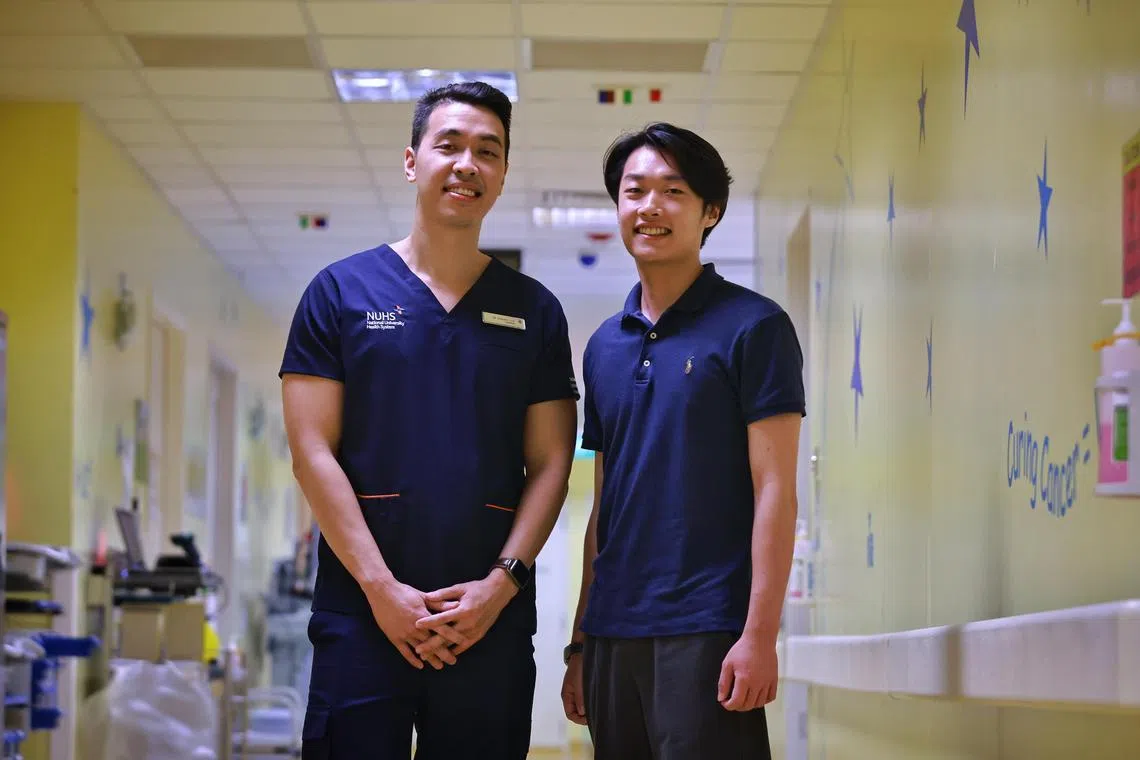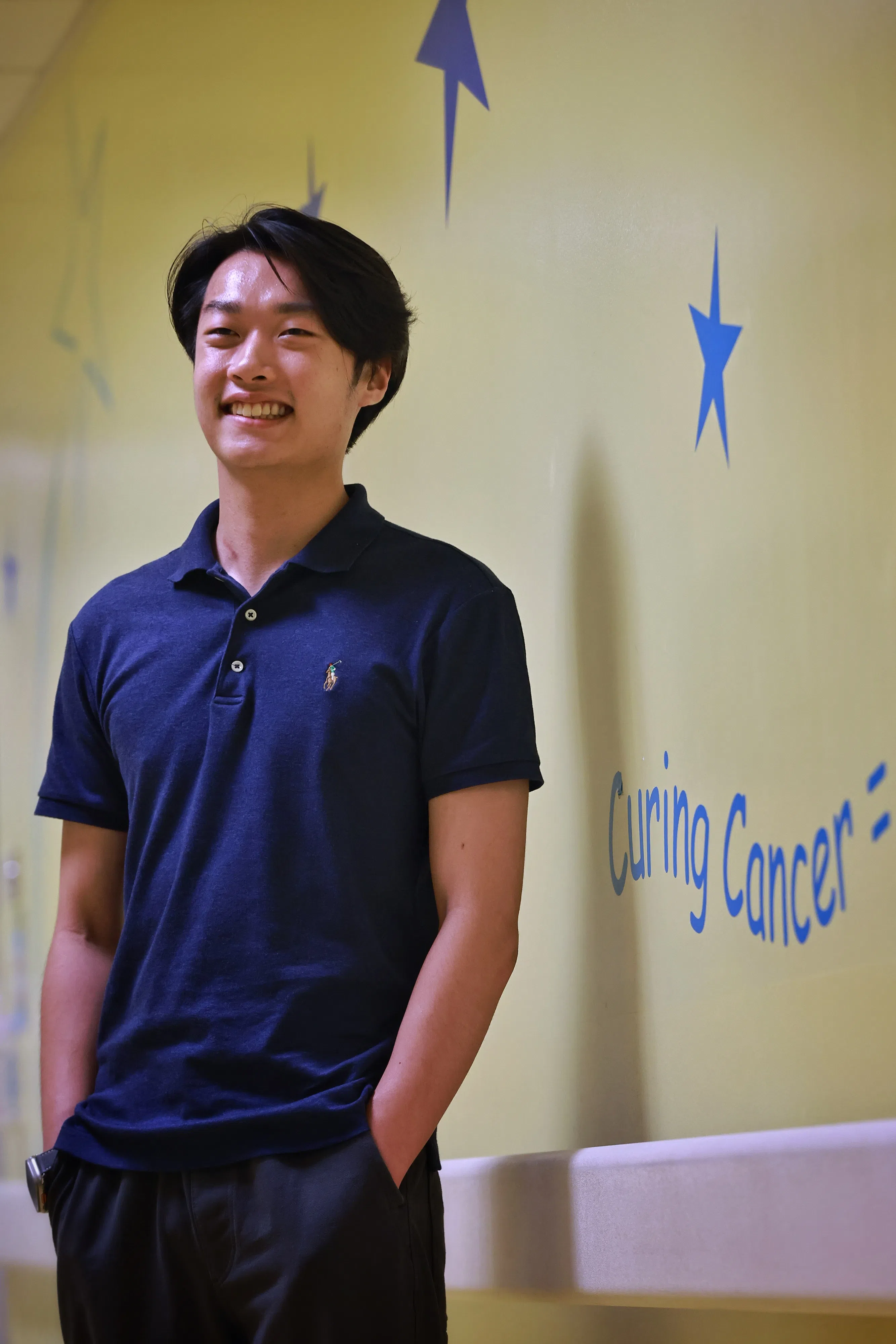Study by S’pore, US doctors to tailor treatment for childhood leukaemia to reduce side effects
Sign up now: Get ST's newsletters delivered to your inbox

Dr Shawn Lee (left) of the National University Hospital, who led the study, with acute lymphoblastic leukaemia survivor Ryan Cho.
ST PHOTO: JASON QUAH
Follow topic:
SINGAPORE - Children who have been diagnosed with acute lymphoblastic leukaemia can typically expect to be given a plethora of different chemotherapy drugs to treat their condition.
The aggressive childhood cancer – known as ALL for short – has many different subtypes, but patients are mostly prescribed a uniform treatment regime involving 10 to 12 different chemotherapy drugs.
This may result in them experiencing a range of side effects, some of which could be lifelong, including limb paralysis, heart damage, and abnormal bone or muscle growth.
But the occurrence and severity of these side effects could soon be minimised with the work of 22 researchers from Singapore and the United States, who are attempting to tailor ALL treatment for each specific subtype to reduce the amount of chemotherapy drugs given to patients.
Their study, published in the journal Nature Medicine in January, evaluated the leukaemia cells of 800 children from six months to 18 years old in the US. The cells were genetically sequenced in a laboratory to determine their subtype and also tested for their response to various chemotherapy drugs. From this, the researchers were able to assess how effective 18 different chemotherapy drugs were in fighting 23 subtypes of ALL.
Though every ALL case is caused by the production of too many lymphocytes (a type of white blood cell) by the bone marrow, the many subtypes – categorised broadly into two groups known as B-cell ALL and T-cell ALL – arise as the specific genetic abnormality found in each patient’s lymphocyte cells may be different.
The study’s results showed that the subtypes reacted differently to individual drugs, which the researchers said was an indication that they should not be treated in an identical way.
For example, early T-cell precursor ALL was found to be generally less responsive to vincristine and daunorubicin, common drugs used in the majority of ALL treatment regimes. Most of the other subtypes, however, were responsive to the two drugs.
Fortunately, newer and potentially more effective drugs such as venetoclax have been identified as a potential replacement for the two medications.
Dr Shawn Lee, a consultant with the National University Hospital’s division of paediatric oncology and haematology who led the study, said: “After analysing which of the chemotherapy drugs were not effective for a particular ALL subtype, we can possibly drop them from the treatment regime in question.
“By removing some of these ineffective drugs that are potentially toxic, we can reduce the impact of the side effects from chemotherapy.”
The study also found that certain chemotherapy drugs could be effective for some ALL subtypes that they were not conventionally used to treat.
For example, dasatinib, a drug normally used to treat a type of B-cell ALL known as Philadelphia-positive ALL, was found to be effective against T-cell ALL as well.
The team hopes to share its work with hospitals here and in the US, and is also planning to incorporate its findings in the design of upcoming ALL trials for children in Singapore and other parts of South-east Asia.
The most common paediatric cancer in Singapore, ALL accounts for about 35 per cent of cancer diagnoses in children locally. This figure is expected to continue increasing in the future.
Said Dr Lee: “With our study that could pave the way for more tailored ALL treatment, I hope that we will be able to defeat patients’ leukaemia in a way that will spare them a lifetime of adverse health effects.”
Doctors not involved in the team’s study said that it advanced the understanding of ALL treatment in the medical community.
Dr Soh Shui Yen, a senior consultant at KK Women’s and Children’s Hospital’s Children’s Blood and Cancer Centre, said the study could lead to more precise diagnoses, enabling more personalised treatment regimes to be developed to achieve the best cancer outcomes, with fewer adverse side effects.

Childhood acute lymphoblastic leukaemia survivor Ryan Cho, an undergraduate, embraced the study findings, saying that he hopes the treatment “blueprint” will help future patients with the cancer.
ST PHOTO: JASON QUAH
Dr Anselm Lee, a paediatric haematologist at Parkway Cancer Centre, also said: “The combination of chemotherapy drugs used to treat childhood ALL has not changed much over the past 30 to 40 years.
“Though the medical community has come to understand that ALL has many different subtypes which have different treatment outcomes – allowing us to use the drugs better by varying their doses, for example – we may have reached a plateau with our current approach in bettering the survival rates of children with ALL.
“This study is one of the first to explore the genomic landscape of leukaemia in detail, and opens a new door for us to tackle the unresolved issues in the treatment of childhood ALL.”
Childhood ALL survivor Ryan Cho, 21, an undergraduate at the Singapore Institute of Management, also embraced the findings.
Diagnosed with the cancer in 2019, Mr Cho, who was then 17, underwent chemotherapy using the standard treatment regime.
After 2½ years of chemotherapy, he made a full recovery from ALL, but was plagued with avascular necrosis in the hips – a condition where the bone tissue dies due to a lack of blood supply – as a result of steroids used in the chemotherapy.
His condition left him limping for months, and deteriorated till he had to go for hip replacement surgery in 2022.
Mr Cho said he hopes this treatment “blueprint” will help future ALL patients.
“I’m very excited about this breakthrough study, which could minimise the side effects that ALL patients face from chemotherapy. Future patients may be able to go for treatment that remedies the cancer without creating other problems in the long run,” he said.

